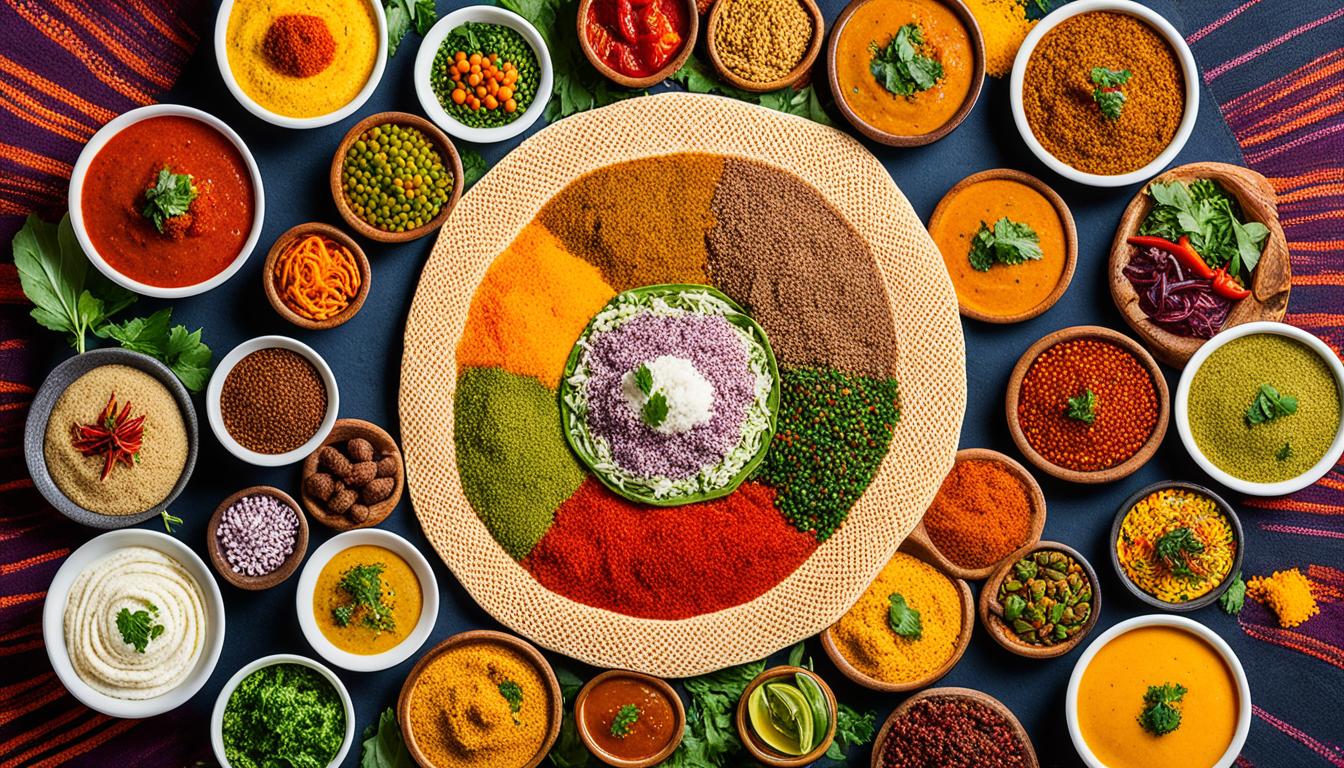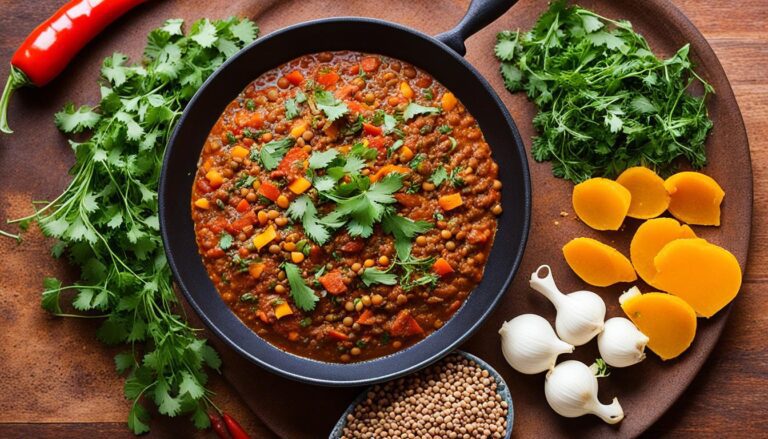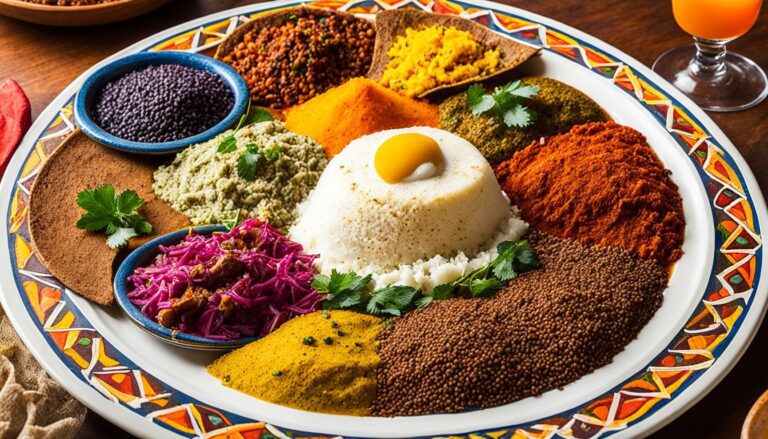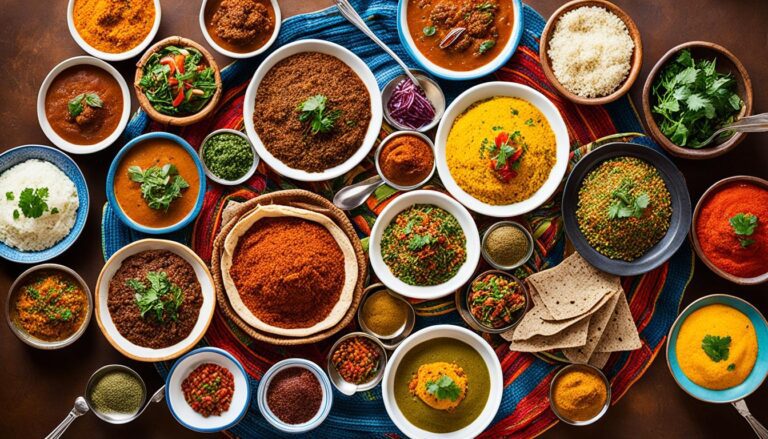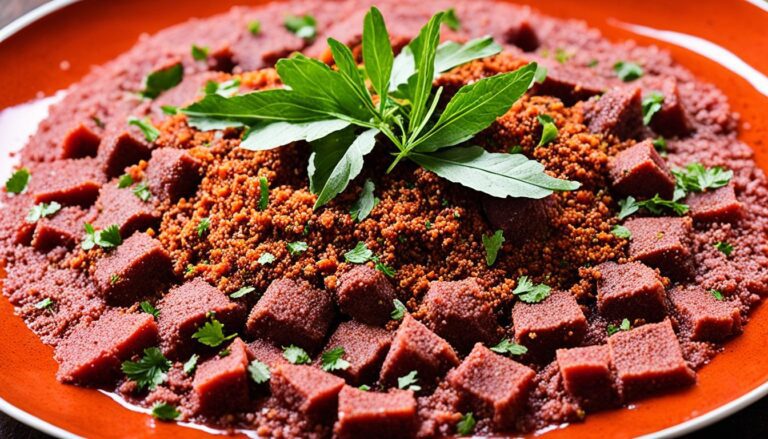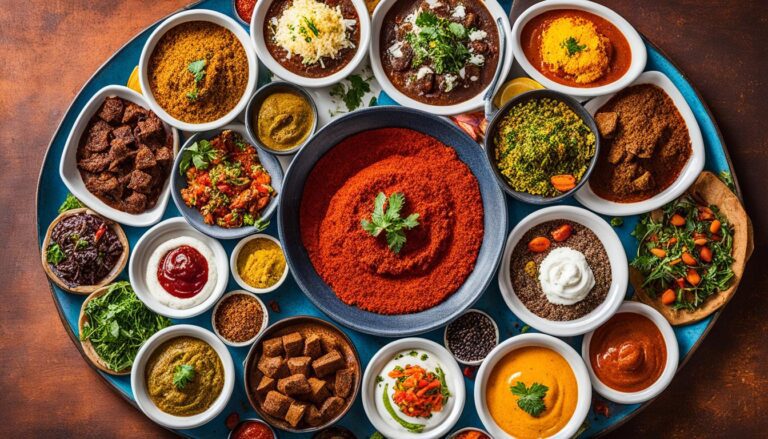Does Ethiopian Food Make You Fat?
When it comes to weight management, we often hear that certain cuisines can contribute to weight gain. But is that really true? Today, we’re diving into the world of Ethiopian food to uncover the truth behind the common belief that it can make you fat.
As with any cuisine, the impact on your weight depends on various factors. From the ingredients used to the cooking techniques employed, Ethiopian food is a rich and diverse culinary tradition that deserves a closer look. So, let’s explore the nutritional profile, the role of traditional dishes, and the potential factors that can contribute to weight gain when enjoying Ethiopian fare.
Key Takeaways:
- Discover the nutritional aspects of Ethiopian cuisine, including its calorie content, essential vitamins and minerals, and high fiber content.
- Explore the significance of injera, the staple bread of Ethiopian cuisine, made from teff flour and fermented using a sourdough technique.
- Learn about strategies for incorporating Ethiopian food into a balanced diet focused on weight management, including portion control and making healthy choices.
- Explore different cooking techniques used in Ethiopian cuisine, such as grilling, steaming, and sautéing, as healthier alternatives to fried foods.
- Examine potential factors that may contribute to weight gain when consuming Ethiopian food, such as high-calorie dishes and overconsumption, and discover strategies to mitigate these risks.
Understanding Ethiopian Cuisine
Explore the vibrant and diverse world of Ethiopian cuisine, a culinary adventure that delights the senses with its unique flavors and cultural heritage. Ethiopian food offers a rich tapestry of traditional dishes, aromatic spices, and a colorful array of ingredients. Let’s delve into the intricacies of this extraordinary culinary tradition and discover the essence of Ethiopian cuisine.
Ethiopian cuisine is a celebration of both tradition and community, where food brings people together to share a meal and foster a sense of belonging. It reflects the country’s cultural diversity and deep-rooted traditions, serving as a gateway to Ethiopian customs and way of life.
Traditional Ethiopian dishes are characterized by their robust flavors and unique cooking techniques. From injera, the beloved sourdough bread made from teff flour, to a variety of stews and vegetable-based dishes, Ethiopian cuisine offers a wealth of options for both meat lovers and vegetarians alike.
One of the defining features of Ethiopian food is the vibrant and aromatic spices that are used to create its distinct flavor profiles. Spices such as berbere, a fiery blend of chili peppers, ginger, and various herbs, add depth and complexity to dishes. Mitmita, another popular Ethiopian spice blend, lends a fiery kick to meat and vegetable dishes.
Additionally, Ethiopian cuisine often incorporates staple ingredients such as lentils, chickpeas, and vegetables that are locally grown and widely available. These ingredients not only contribute to the richness of the cuisine but also add a nutritional element to the dishes.
Exploring Ethiopian cuisine is not just about savoring delicious food; it’s also about experiencing the cultural significance behind each dish. Injera, for example, plays a central role in Ethiopian meals, serving as a versatile and nutritious accompaniment to various stews and dishes. Its tangy flavor and spongy texture make it a delightful complement to the bold flavors of Ethiopian cuisine.
Whether you’re a seasoned fan of Ethiopian food or a curious food enthusiast, delving into its traditional dishes and spices provides a fascinating window into the rich cultural fare that is Ethiopian cuisine.
Nutritional Profile of Ethiopian Food
When it comes to Ethiopian cuisine, not only does it tantalize our taste buds, but it also offers an array of nutritional benefits. Let’s explore the remarkable nutritional value of this vibrant and flavorful culinary tradition.
One of the key aspects of Ethiopian food is its moderate calorie content. Many traditional dishes incorporate a variety of vegetables, lentils, and beans, which are low in calories and high in nutrients. This makes Ethiopian food an excellent choice for those looking to maintain a healthy weight or manage their calorie intake.
In addition to being relatively low in calories, Ethiopian cuisine is packed with essential vitamins and minerals. The diverse range of spices and ingredients used in Ethiopian dishes provides an abundance of beneficial nutrients. From Vitamin A and Vitamin C to iron and potassium, these vitamins and minerals play a vital role in supporting overall health.
Moreover, Ethiopian food is known for its high fiber content. The teff flour used in staple dishes like injera, the traditional Ethiopian bread, is rich in fiber. Fiber not only aids in digestion but also promotes a feeling of fullness, leading to better appetite control and weight management.
The Importance of Fiber in Ethiopian Cuisine
Let’s take a closer look at the role of fiber in Ethiopian food. Fiber is a type of carbohydrate that passes through the digestive system relatively intact. It adds bulk to the diet and aids in bowel movement regularity. Ethiopian cuisine, with its incorporation of legumes, vegetables, and whole grains, provides a significant amount of dietary fiber, offering both digestive benefits and a reduced risk of chronic diseases such as heart disease and diabetes.
The combination of low-calorie content, essential vitamins and minerals, and high fiber content makes Ethiopian cuisine a well-rounded and nutritious option. By enjoying the flavors of Ethiopian dishes, you not only satisfy your taste buds but also provide your body with the nourishment it needs.
To get a visual representation of the nutrient-rich Ethiopian cuisine, take a look at the comprehensive table below:
| Dish | Nutritional Value per Serving |
|---|---|
| Key Wat with Injera | Calories: 350 Vitamins: A, C, K Minerals: Iron, Potassium Fiber: 5g |
| Misir Wat | Calories: 200 Vitamins: B6, C Minerals: Iron Fiber: 8g |
| Gomen | Calories: 120 Vitamins: A, C, K Minerals: Calcium, Iron Fiber: 4g |
As you can see, Ethiopian food offers a wide range of nutritional benefits, including vitamins, minerals, and fiber. So the next time you savor a delectable Ethiopian meal, not only will you be treating your taste buds, but you’ll also be nourishing your body with a diverse array of nutrients.
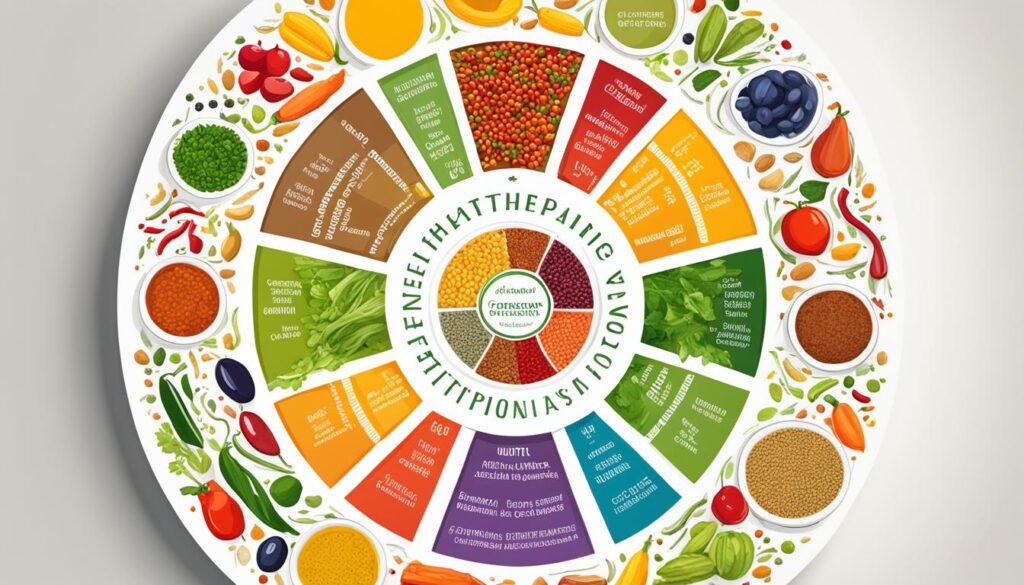
The Role of Injera in Ethiopian Cuisine
When exploring Ethiopian cuisine, it’s impossible to overlook the significance of injera, the traditional bread that accompanies nearly every meal. Made from teff flour and fermented using a sourdough technique, injera is a staple in Ethiopian culture and plays a vital role in their culinary traditions.
Injera is a unique type of bread that is both soft and spongy, with a slightly tangy taste. Its distinct texture and flavor make it a perfect accompaniment to rich and flavorful Ethiopian stews, known as wats. It serves as a versatile eating utensil, with diners tearing off pieces of injera to scoop up the delicious dishes.
One of the reasons injera holds such importance in Ethiopian cuisine is its impact on digestion. The sourdough fermentation process breaks down complex carbohydrates, making injera easier to digest. Additionally, teff flour, the main ingredient in injera, is naturally gluten-free and packed with nutrients.
From a nutritional perspective, injera is a good source of fiber, iron, and protein, making it a valuable addition to any diet. The fermentation process also increases the bioavailability of these nutrients, allowing our bodies to absorb them more effectively.
While injera is undeniably delicious, it’s essential to consider its impact on your overall calorie intake. Injera, like any bread, contains calories, so it’s important to practice moderation. Balancing your injera consumption with other nutrient-rich components of Ethiopian cuisine, such as vegetables and lean proteins, can help maintain a healthy calorie balance.
In conclusion, injera plays a vital role in Ethiopian cuisine, adding flavor, texture, and cultural significance to meals. Its unique fermentation process and use of teff flour provide distinct health benefits and contribute to a well-rounded diet. By incorporating injera in moderation and balancing it with other nutritious components, you can fully enjoy the rich flavors of Ethiopian cuisine while maintaining a healthy lifestyle.
Balancing Ethiopian Food for Weight Management
When it comes to weight management, finding a balance between enjoying delicious Ethiopian cuisine and maintaining a healthy lifestyle is essential. Let’s explore some strategies that can help you incorporate Ethiopian food into your diet while still achieving and maintaining a healthy weight.
Portion Control
One key aspect of managing your weight is practicing portion control. While Ethiopian dishes are known for their generous portions, it’s important to be mindful of how much you consume. Instead of mindlessly indulging, try to listen to your body’s hunger and fullness cues. Choose smaller plates or share dishes with friends to avoid overeating.
Additionally, focusing on nutrient-dense foods can help you feel satisfied with smaller portions. Opt for dishes that are rich in vegetables, legumes, and lean proteins. These choices will provide you with essential nutrients while keeping your calorie intake in check.
Moderation and Healthy Choices
Another key factor in balancing Ethiopian food for weight management is moderation. While certain dishes may be higher in calories, enjoying them occasionally in moderation can still be part of a healthy diet. Instead of completely avoiding your favorite Ethiopian dishes, plan for them as occasional treats.
Furthermore, making healthy choices within the Ethiopian cuisine can contribute to maintaining your weight. Select dishes that are grilled, steamed, or sautéed instead of fried options. By opting for healthier cooking techniques, you can reduce the overall calorie content without compromising on flavor.
Exercise and Movement
Alongside portion control and healthy choices, regular exercise plays a crucial role in weight management. Engaging in physical activity helps burn calories and supports overall well-being. Find activities you enjoy, such as walking, jogging, dancing, or even Ethiopian traditional dances like Eskista. Incorporating exercise into your routine will help offset any excess calories consumed.
A Balanced Approach
Remember, achieving and maintaining a healthy weight is not just about indulging in Ethiopian food but adopting a well-rounded approach to your overall lifestyle. Embrace portion control, make healthier choices, engage in regular exercise, and listen to your body’s needs. By finding a balance, you can savor the flavors of Ethiopian cuisine while still prioritizing your health and weight management goals.
Cooking Techniques and Healthier Alternatives
When it comes to Ethiopian cuisine, there are various cooking techniques that can be employed to make dishes healthier and more nutritious. By exploring alternatives to fried foods and embracing different cooking methods, you can enjoy the flavors of Ethiopian food while making healthier choices. Let’s dive into some of these techniques and alternatives.
Grilling
Grilling is a popular cooking method that not only adds a smoky flavor to dishes but also helps to reduce the amount of added fats and oils. Whether it’s marinated meats, vegetables, or even injera, grilling can be a flavorful and healthier way to prepare Ethiopian dishes. The high heat helps to cook the food quickly, preserving its natural flavors and minimizing the need for excess oils.
Steaming
Steaming is another cooking technique that can be used to create healthier Ethiopian meals. By heating food using steam rather than oil or butter, you can retain more of the natural nutrients and flavors. This method is particularly suited for vegetables, such as collard greens or cabbage, and it helps to maintain their vibrant colors and crisp textures.

Sautéing
Sautéing involves cooking food quickly in a small amount of oil or butter over high heat. It’s a versatile technique that can be used for various Ethiopian ingredients, such as onions, garlic, or spices. By using just a small amount of oil and stirring frequently, you can achieve the desired flavors without excess fat. Remember to choose heart-healthy oils like olive oil or avocado oil for sautéing.
By embracing these cooking techniques and healthier alternatives, you can enjoy Ethiopian cuisine while making conscious choices for your well-being. Whether you prefer the charred flavors of grilled dishes, the vibrant freshness of steamed vegetables, or the aromatic sautéed spices, these methods offer delicious and nutritious options. So, let’s get cooking and savor the flavors of Ethiopia in a healthier way!
Potential Factors Contributing to Weight Gain
When it comes to maintaining a healthy weight, it’s important to consider various factors that can contribute to weight gain. This holds true even when enjoying Ethiopian food. Despite its rich flavors and cultural significance, certain aspects of Ethiopian cuisine can lead to overconsumption and high-calorie intake if not approached with moderation and balance.
One potential factor is the presence of high-calorie dishes in Ethiopian cuisine. While traditional Ethiopian dishes often showcase a variety of nutritious ingredients, some preparations may incorporate calorie-dense components. Dishes like doro wat (spicy chicken stew) and kitfo (minced raw meat) can be high in calories and fat content.
Overconsumption is another concern that can arise when indulging in Ethiopian food. The communal style of eating, with everyone sharing from a central platter, can make it easy to lose track of portion sizes and inadvertently consume more than one would in an individual serving. By mindfully monitoring portion sizes and practicing moderation, the risk of overeating can be mitigated.
Additionally, a lack of physical activity can contribute to weight gain when consuming high-calorie dishes. If one consistently consumes calorie-rich meals without engaging in regular exercise, the excess energy is likely to be stored as fat. It is important to pair the enjoyment of Ethiopian food with an active lifestyle to maintain a healthy balance.
Strategies to Mitigate Risks
Fortunately, there are strategies that can help mitigate the potential risks of weight gain when enjoying Ethiopian cuisine. Firstly, being mindful of portion sizes and practicing portion control is key. By being aware of the amount of food being consumed and listening to our body’s signals of fullness, we can avoid overeating.
Furthermore, incorporating healthier choices into our Ethiopian meals can make a difference. Opting for grilled or steamed dishes instead of fried options can reduce calorie intake while still allowing us to savor the flavors of Ethiopian spices. Choosing leaner cuts of meat or vegetarian dishes rich in legumes and vegetables can also contribute to a more balanced meal.
Lastly, maintaining an active lifestyle that includes regular physical activity is crucial for weight management. Engaging in exercises such as walking, running, or even traditional Ethiopian dance can help counterbalance the calorie intake and promote overall health and well-being.
Conclusion
Throughout this article, we have explored the world of Ethiopian cuisine and its potential impact on weight management. While it is true that certain high-calorie dishes and overconsumption can lead to weight gain, it is important to view Ethiopian food within the broader context of overall healthy lifestyle choices.
When enjoying Ethiopian cuisine, moderation is key. By practicing portion control and making mindful choices, you can savor the diverse flavors of traditional Ethiopian dishes without compromising your weight management goals. Remember, it is not just about the type of cuisine you consume, but also the balance and quantity.
Additionally, incorporating regular exercise into your routine is crucial for maintaining a healthy weight. By staying active, you can offset any potential excess calorie intake and promote overall well-being. So, whether you indulge in injera or any other cuisine, remember that balance and an active lifestyle are essential for successful weight management.

